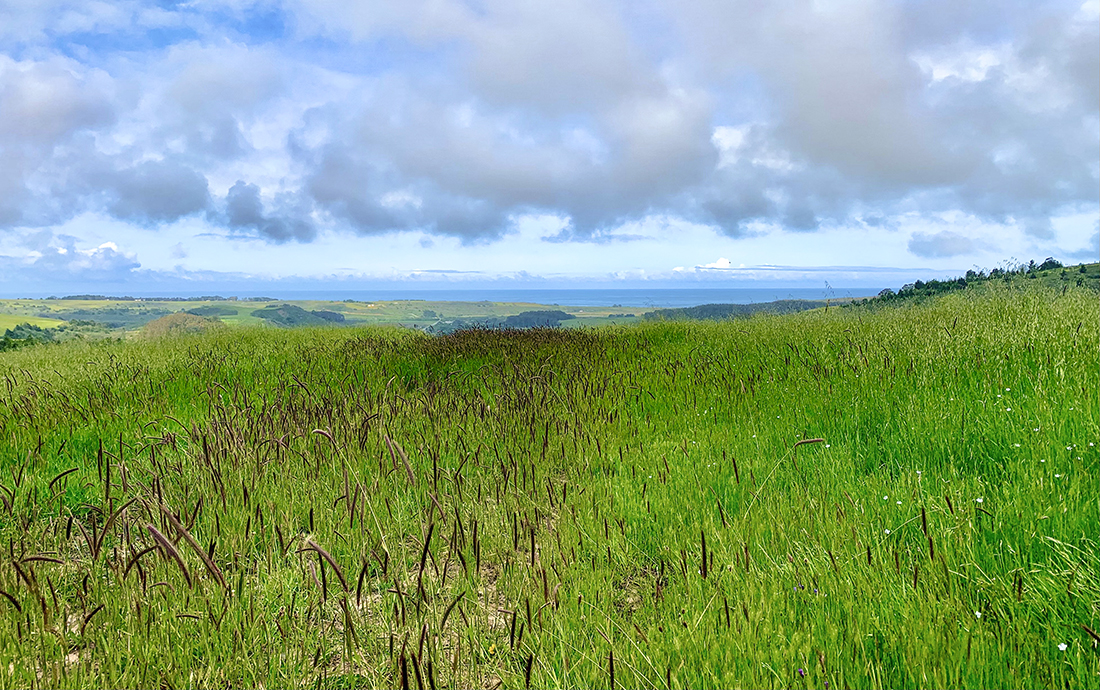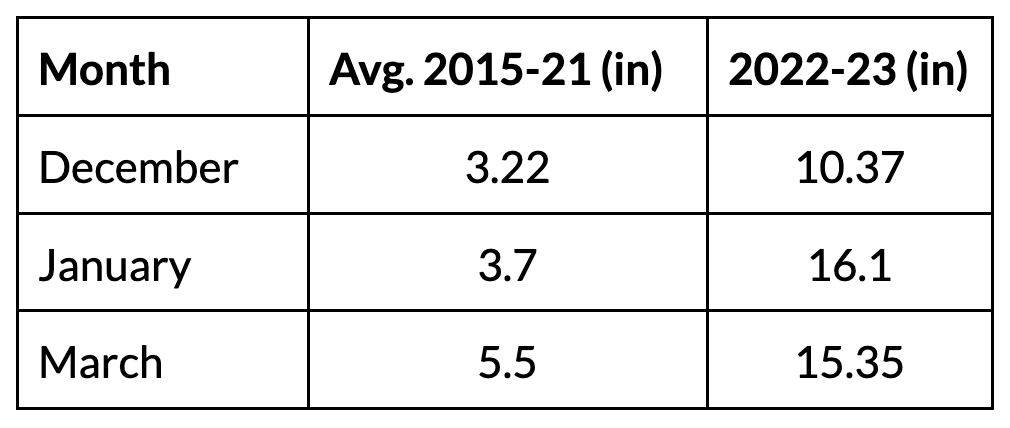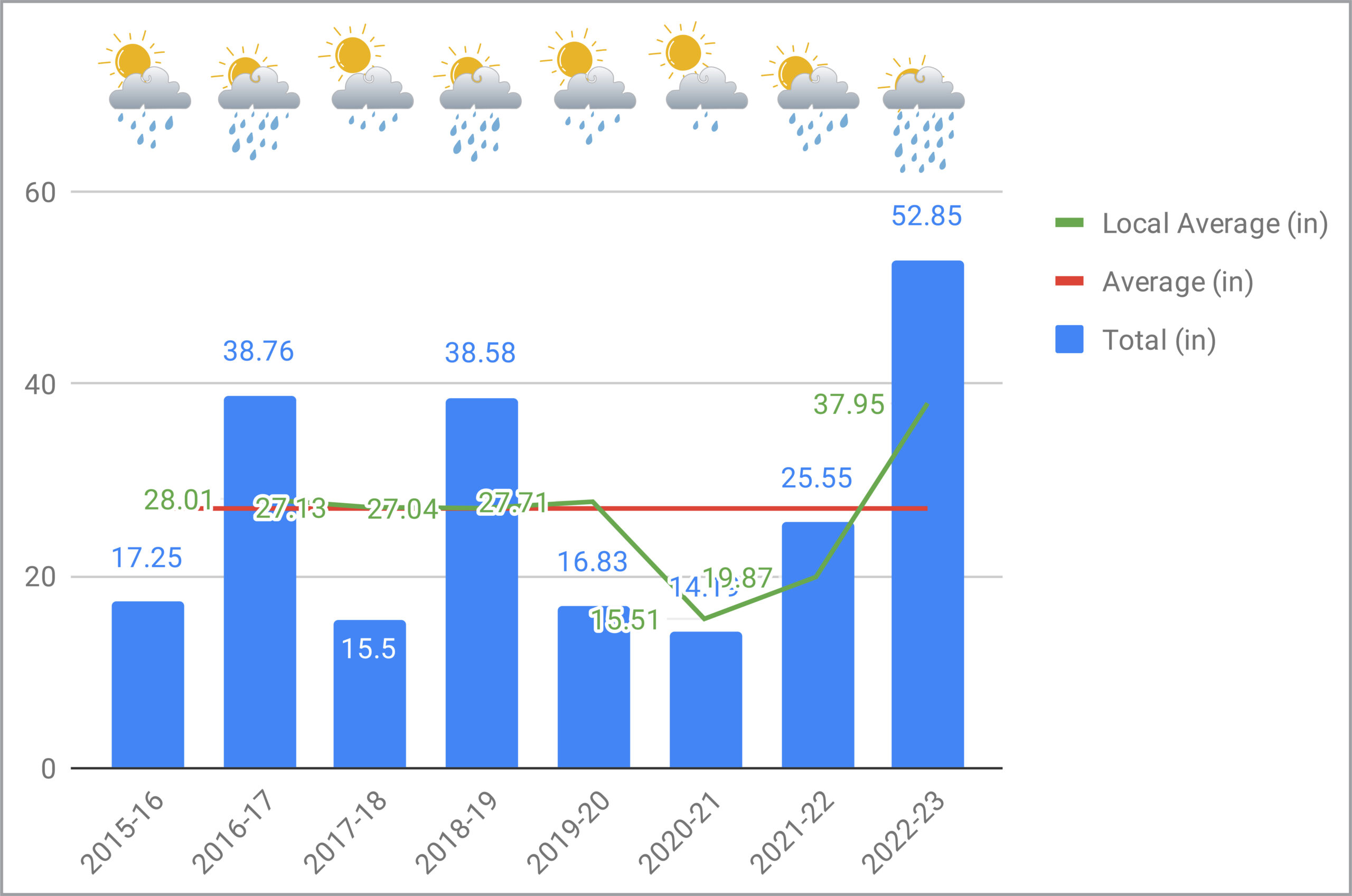Always on the lookout for landscape changes, we observed annual grasses, most of which are non-native,
The State of our Grasses 2022-23
A Rangeland Update

A mosaic of grass species growing as a result of our exceptionally wet year. Many are perennial grasses that eventually thrived compared to the stunted annual grasses. Photo: Hayley Strohm
By: Mark Biaggi. Edits by: Megan Shahan and Bill Milliot
 TomKat Ranch, like the rest of California, has enjoyed and struggled under the impact of an extraordinary 2022-23 rainy season. As of the first week of May, we have received 52-inches of rain, more than 195.7% of the regional average and triple the 14 inches of rain we got two seasons ago. During the swarm of atmospheric rivers in December, January, and March, rainfall exceeded that of the seven seasons prior.
TomKat Ranch, like the rest of California, has enjoyed and struggled under the impact of an extraordinary 2022-23 rainy season. As of the first week of May, we have received 52-inches of rain, more than 195.7% of the regional average and triple the 14 inches of rain we got two seasons ago. During the swarm of atmospheric rivers in December, January, and March, rainfall exceeded that of the seven seasons prior.
Across California, this extraordinarily wet and windy season brought with it both benefits and challenges. In Pescadero, rain replenished the soil and aquifers, revitalized shrunken riparian areas, flushed streams of sediment creating deep pools for fish and habitats for aquatic creatures (frogs, salamanders, etc.), rebalanced small rodent populations, and extended the growing season. On the flipside, trees fell, landslides saw soil tumble down slopes, and roads flooded or sunk into the earth. Some of these impacts were inevitable events of a natural system. Others were consequences of human influence on the landscape and climate alike.

At TomKat Ranch, month after month of atmospheric rivers brought interesting observations, challenges, and benefits. Always on the lookout for landscape changes, we observed annual grasses, most of which are non-native, had limited growth. Our theory is that a combination of factors led to the overall decrease in annual cool season grass production this year, including:
- Saturated and likely anaerobic soil conditions: Based on our observations, the volume of rain brought by the atmospheric rivers saturated soils, creating non-optimal conditions for annual cool season grasses to grow. Saturated soils likely created anaerobic (little to no oxygen) conditions suspending microbial activity and arresting grass growth, particularly of winter annuals.
- Diffuse sunlight, less solar energy, less photosynthesis: Overcast conditions for a period of 90+ days meant less solar energy to fuel photosynthesis which in turn may have reduced plant growth, carbon sequestration, and available energy to feed soil microbes.
- Cooler than average temperatures? Winter temperatures on the coast averaged ~4℉ colder than normal. Cool season grasses prefer temperatures of 65-75℉ and growth begins when soil temperatures are 40-45℉. Did cooler soils inhibit soil microbial activity and therefore plant growth? These are all factors we need to consider as we think about grazing planning in changing climatic conditions.
Needless to say, limited growth of annual grasses during January-April presented a grazing management challenge and adapting to winter rains was a dynamic balance between multiple interrelated goals, including: 1) avoiding compacting saturated soils, 2) ensuring cattle and goat herds received proper nutrition for Spring calving and kidding, and 3) allowing adequate rest and recovery time for grasses.

Rainfall pattern at TomKat Ranch over the past seven years. The impact on our grazing grasses is directly correlated.
Now that the days have warmed and the rains have been replaced by coastal fog and scattered sunshine, we can celebrate:
- Benefits of years of soil building that increased our lands’ capacity for water infiltration and storage; our ponds are now filled to capacity.
- Perennial grasses, such as meadow barley (pictured) and purple needlegrass, are thriving and will likely have an extended growing season.
- Success of our erosion gully restoration projects which stood up to the true test of 2022-23 rains.
- As of mid-May, we have welcomed 42 calves and 40 kids to the ranch so far!
We are grateful for water, our most limited resource, and all the life that springs from it.